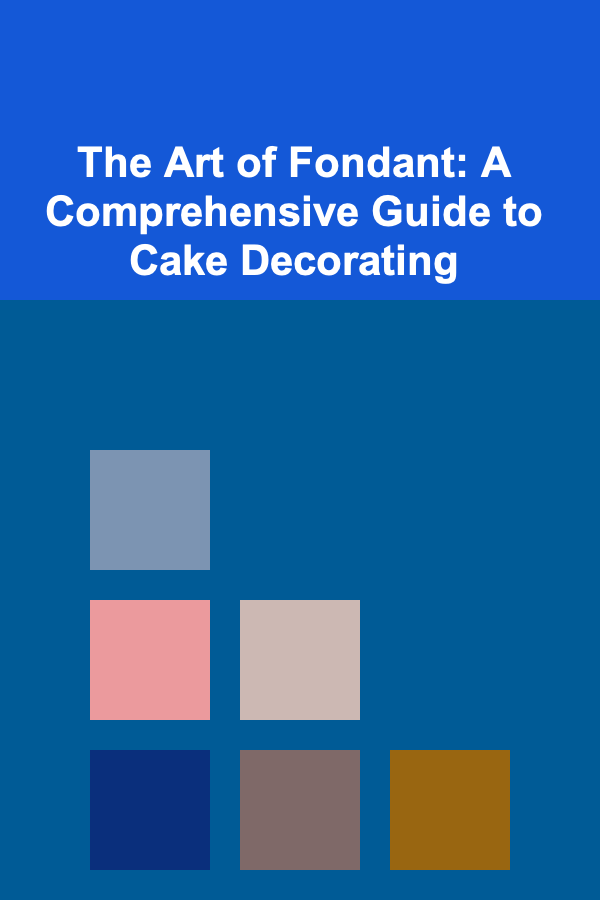
The Art of Fondant: A Comprehensive Guide to Cake Decorating
ebook include PDF & Audio bundle (Micro Guide)
$12.99$7.99
Limited Time Offer! Order within the next:

Fondant, the smooth, pliable icing that transforms ordinary cakes into edible works of art, has captivated bakers and decorators for generations. Its versatility allows for intricate designs, flawless finishes, and a level of detail unmatched by other cake decorating mediums. But working with fondant can be daunting, especially for beginners. This comprehensive guide delves deep into the world of fondant, providing you with the knowledge and techniques to master this captivating craft.
Understanding Fondant: Types and Properties
Before diving into decorating, it's crucial to understand the different types of fondant available and their unique properties. Choosing the right fondant for your project will significantly impact the final outcome.
Rolled Fondant
This is the most common type of fondant and is what most people think of when they hear the word "fondant." Rolled fondant is typically used to cover entire cakes, create cut-out shapes, and model simple decorations. It's known for its smooth, matte finish and ability to hold its shape well. There are many commercially available brands of rolled fondant, each with its own texture, flavor, and ease of use. Some popular brands include Satin Ice, Fondarific, and Renshaw. You can also make rolled fondant from scratch, which allows you to control the ingredients and flavor.
Key Characteristics:
- Smooth, matte finish
- Excellent for covering cakes and creating flat shapes
- Can be colored with gel food coloring
- Requires kneading and rolling to achieve a smooth consistency
Modeling Chocolate
While technically not fondant, modeling chocolate shares many of the same characteristics and is often used in conjunction with fondant. Made from melted chocolate and corn syrup, modeling chocolate is incredibly pliable and can be molded into complex shapes and figures. It's less likely to tear than fondant and holds its shape exceptionally well, making it ideal for creating 3D elements like flowers, animals, and architectural details.
Key Characteristics:
- Smooth, chocolatey flavor
- Extremely pliable and easy to mold
- Excellent for creating 3D sculptures
- Less prone to tearing than fondant
Gumpaste
Gumpaste is a sugar paste that dries incredibly hard, making it perfect for creating delicate and intricate decorations that need to hold their shape, such as flowers, bows, and fine details. Gumpaste is more fragile than fondant or modeling chocolate and requires a skilled hand to work with, as it can dry out quickly and become brittle. It's often mixed with fondant to create a "fondant-gumpaste" mixture, which combines the pliability of fondant with the strength of gumpaste.
Key Characteristics:
- Dries hard and holds its shape exceptionally well
- Ideal for creating delicate and intricate decorations
- More fragile and dries faster than fondant
- Often mixed with fondant for added strength
Marzipan
Made from ground almonds, sugar, and egg whites, marzipan offers a unique flavor and texture compared to other types of fondant. While not as smooth as rolled fondant, marzipan can be molded, sculpted, and even colored. It's often used for creating fruit shapes and other realistic-looking decorations. Marzipan has a distinct almond flavor that some people love and others dislike, so it's important to consider your audience's preferences before using it.
Key Characteristics:
- Distinct almond flavor
- Can be molded and sculpted
- Less smooth than rolled fondant
- Can be colored, but the colors may be less vibrant
Essential Tools for Fondant Decorating
Having the right tools is essential for successful fondant decorating. While some projects can be accomplished with minimal equipment, investing in a few key tools will make the process much easier and more enjoyable.
- Rolling Pin: A smooth, non-stick rolling pin is crucial for rolling out fondant evenly. Consider a rolling pin specifically designed for fondant, which is often made of a non-stick material like silicone or plastic.
- Fondant Smoother: This tool is used to smooth out any imperfections on the fondant after it's been applied to the cake. Smoothers come in various shapes and sizes, but a basic smoother with rounded edges is a good starting point.
- Cutting Tools: Sharp knives, X-Acto knives, and cookie cutters are essential for cutting out shapes and creating clean lines.
- Modeling Tools: These tools are used to shape and mold fondant into various decorations. Common modeling tools include ball tools, bone tools, and veining tools.
- Cornstarch or Powdered Sugar: These are used to prevent the fondant from sticking to the rolling pin, work surface, or your hands.
- Vegetable Shortening: A small amount of vegetable shortening can be used to soften fondant that is too stiff or to repair minor cracks.
- Edible Glue: Edible glue is used to adhere fondant decorations to the cake. It can be made by dissolving a small amount of tylose powder in water.
- Gel Food Coloring: Gel food coloring is the best type of coloring to use for fondant, as it is highly concentrated and won't change the consistency of the fondant.
- Fondant Mat or Silicone Work Surface: A non-stick surface is essential for working with fondant.
- Turntable: A rotating cake turntable makes it easier to apply fondant and decorate the cake evenly.
Preparing Your Cake for Fondant
The foundation of any beautifully decorated cake lies in the preparation. A properly prepared cake will provide a smooth and even surface for the fondant, resulting in a professional-looking finish. Here's a step-by-step guide to preparing your cake for fondant:
- Bake and Cool Your Cake: Bake your cake according to your favorite recipe and allow it to cool completely. Level the cake layers using a serrated knife to ensure they are even.
- Prepare Your Buttercream: A crumb coat of buttercream is essential for creating a smooth surface for the fondant. Use a stiff buttercream recipe that will hold its shape well.
- Apply a Crumb Coat: Apply a thin layer of buttercream to the entire cake. This layer will trap any crumbs and prevent them from showing through the fondant.
- Chill the Cake: Refrigerate the crumb-coated cake for at least 30 minutes to allow the buttercream to firm up.
- Apply a Final Layer of Buttercream: Apply a final, thicker layer of buttercream to the cake, smoothing it as much as possible. Use a cake scraper or spatula to achieve a smooth, even surface.
- Chill Again: Return the cake to the refrigerator for another 30 minutes to allow the buttercream to set completely. The buttercream should be firm to the touch before applying the fondant. A firm, cold buttercream is critical for creating a sharp edge on your fondant.
Covering a Cake with Fondant: A Step-by-Step Guide
Covering a cake with fondant might seem intimidating, but with practice and patience, you can achieve a flawless finish. Follow these steps for a smooth and professional-looking fondant covering:
- Knead the Fondant: Knead the fondant until it is soft and pliable. This process helps to release any air bubbles and makes the fondant easier to work with. If the fondant is too stiff, add a small amount of vegetable shortening or glycerin.
- Color the Fondant (Optional): If you want to color your fondant, add gel food coloring a few drops at a time, kneading until the color is evenly distributed. Be careful not to add too much coloring, as this can make the fondant sticky.
- Roll Out the Fondant: Lightly dust your work surface and rolling pin with cornstarch or powdered sugar. Roll out the fondant to a thickness of about 1/8 inch, making sure it's large enough to cover the entire cake with some excess. To check the size, you can use a piece of string to measure the height and diameter of your cake and then add those numbers together to get the minimum diameter for your fondant circle.
- Lift and Drape the Fondant: Carefully lift the fondant using your rolling pin or by gently draping it over your hands. Center the fondant over the cake.
- Smooth the Fondant: Starting at the top of the cake, gently smooth the fondant down the sides using your hands or a fondant smoother. Work your way around the cake, removing any air bubbles as you go.
- Trim the Excess Fondant: Use a sharp knife or pizza wheel to trim the excess fondant around the base of the cake. Leave about an inch of excess to tuck under.
- Smooth the Base: Use a fondant smoother to smooth the base of the cake and create a clean, sharp edge.
- Tuck and Seal: Gently tuck the remaining fondant under the base of the cake, sealing it to the buttercream.
- Final Smoothing: Give the entire cake a final smoothing with the fondant smoother to remove any remaining imperfections.
Fondant Decorating Techniques: From Simple to Advanced
Once you've mastered the art of covering a cake with fondant, the possibilities for decorating are endless. Here are a few popular fondant decorating techniques, ranging from simple to advanced:
Cut-Outs
Creating fondant cut-outs is a simple yet effective way to add decorative elements to your cake. Use cookie cutters or templates to cut out shapes from rolled fondant and adhere them to the cake using edible glue. You can create simple shapes like stars and hearts, or more intricate designs like flowers and animals.
Modeling
Modeling fondant allows you to create 3D figures and sculptures. Start with simple shapes and gradually work your way up to more complex designs. Use modeling tools to shape and mold the fondant into the desired form. Modeling chocolate is often preferred for 3D work due to its pliability.
Draping and Swags
Draping and swags add a touch of elegance to your cake. Roll out fondant into thin strips and drape them over the cake to create flowing lines and curves. Secure the drapes with edible glue or toothpicks.
Ruffles and Flowers
Fondant ruffles and flowers can transform a plain cake into a stunning centerpiece. Use a rolling pin to thin the edges of fondant petals and then shape them to create realistic-looking flowers. For ruffles, roll out a thin strip of fondant and pleat it along one edge.
Painting and Airbrushing
Painting and airbrushing allow you to add intricate details and shading to your fondant decorations. Use edible paints or airbrush colors to create realistic effects and personalized designs. Practice on scrap fondant before painting on your cake.
Quilting
The quilting technique gives a cake a textured and elegant look. Use a quilting tool or a ruler and a knife to create a diamond or square pattern on the fondant. You can then add edible pearls or dragees to the intersections of the lines for added detail.
Stenciling
Stenciling is a great way to add intricate patterns to your fondant-covered cake. Use a stencil and royal icing, edible paint, or cocoa powder to create a design on the cake's surface.
Troubleshooting Common Fondant Problems
Even experienced decorators encounter problems when working with fondant. Here are some common issues and their solutions:
- Fondant is too sticky: Add more powdered sugar or cornstarch to the fondant and knead it in thoroughly.
- Fondant is too dry or cracking: Add a small amount of vegetable shortening or glycerin to the fondant and knead it in until it becomes pliable.
- Air bubbles under the fondant: Use a pin to prick the air bubbles and then smooth the fondant over them.
- Tears in the fondant: Use a small amount of vegetable shortening to patch the tears.
- Fondant is sagging: Make sure the buttercream underneath is firm and cold. You can also add a small amount of tylose powder to the fondant to help it firm up.
- Elephantskin (a rippled or bumpy texture): Usually caused by temperature changes or humidity. Ensure your cake and fondant are at a consistent temperature. Work quickly in humid environments.
Tips and Tricks for Success
Here are some additional tips and tricks to help you succeed with fondant decorating:
- Practice makes perfect: Don't be discouraged if your first attempts aren't perfect. The more you practice, the better you'll become.
- Work in a cool, dry environment: Humidity can make fondant sticky and difficult to work with.
- Store fondant properly: Wrap unused fondant tightly in plastic wrap and store it in an airtight container to prevent it from drying out.
- Use quality ingredients: The quality of your ingredients will affect the taste and texture of your fondant.
- Don't be afraid to experiment: Try different techniques and designs to find what works best for you.
- Watch tutorials and take classes: There are many online tutorials and in-person classes that can help you learn more about fondant decorating.
- Plan your design in advance: Sketch out your design before you start working with the fondant to ensure you have a clear vision.
Conclusion
Fondant decorating is a rewarding and creative skill that allows you to transform ordinary cakes into stunning works of art. While it may seem challenging at first, with practice, patience, and the right tools, you can master the art of fondant and create cakes that will impress your friends, family, and clients. Remember to start with simple techniques and gradually work your way up to more complex designs. Don't be afraid to experiment and have fun with the process. With dedication and creativity, you'll be creating edible masterpieces in no time!

How to Build Multiple Income Streams for Financial Freedom
Read More
How To Discover Trailblazing Female Rock Musicians
Read More
How to Handle Rent Increases in Your Rental Property
Read More
How to Make Money Online as an Occupational Therapist: 10 Actionable Ideas
Read More
How to Master Live Streaming for Events
Read More
Quantum Computing's Impact on Blockchain: A Deep Dive
Read MoreOther Products

How to Build Multiple Income Streams for Financial Freedom
Read More
How To Discover Trailblazing Female Rock Musicians
Read More
How to Handle Rent Increases in Your Rental Property
Read More
How to Make Money Online as an Occupational Therapist: 10 Actionable Ideas
Read More
How to Master Live Streaming for Events
Read More